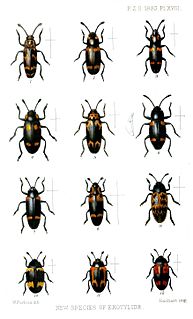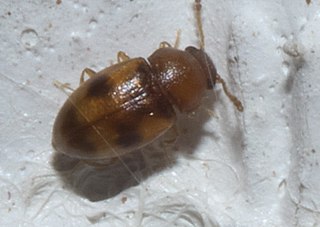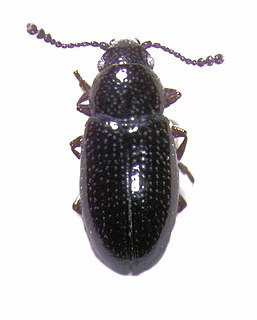
Erotylidae, or the pleasing fungus beetles, is a family of beetles containing over 100 genera. In the present circumscription, it contains 6 tribes and 10 subfamilies. In other words, the narrowly circumscribed Erotylidae correspond to the subfamily Erotylinae in the definition sensu lato. There are doubts on the monophyly of lower ranked taxa within Erotylidae, with further phylogenetic studies requiring better sampling and studies of unexplored character sets, for example the metendosternite and penile flagellum, which are generally lacking detailed morphological studies within the Coleoptera literature.

Ischyrus is a genus of pleasing fungus beetles in the family Erotylidae. There are at least three described species in Ischyrus.

Toramus is a genus of pleasing fungus beetles in the family Erotylidae. There are about nine described species in Toramus.

Languria is a genus of lizard beetles in the family Erotylidae. There are about 18 described species in Languria.

Pharaxonotha is a genus of pleasing fungus beetles in the family Erotylidae. There are at least three described species in Pharaxonotha.

Loberus is a genus of pleasing fungus beetles in the family Erotylidae. There are about 16 described species in Loberus.
Pseudischyrus is a genus of pleasing fungus beetles in the family Erotylidae. There are at least four described species in Pseudischyrus.
Hirsutotriplax is a genus of pleasing fungus beetles in the family Erotylidae. There is one described species in Hirsutotriplax, H. mcclevei.
Salebius is a genus of silken fungus beetles in the family Cryptophagidae. There are at least four described species in Salebius.
Haematochiton is a genus of pleasing fungus beetles in the family Erotylidae. There are at least three described species in Haematochiton.

Ischyrus quadripunctatus, the four-spotted fungus beetle, is a species of pleasing fungus beetle in the family Erotylidae. It is found in the Caribbean Sea, Central America, North America, and South America.

Cryptophilus is a genus of pleasing fungus beetles in the family Erotylidae. There are about nine described species in Cryptophilus.
Dasydactylus is a genus of lizard beetles in the family Erotylidae. There is one described species in Dasydactylus, D. cnici.
Hapalips is a genus of pleasing fungus beetles in the family Erotylidae. There are about 12 described species in Hapalips.
Tritoma biguttata is a species of pleasing fungus beetle in the family Erotylidae. It is found in North America.
Dacne pubescens is a species of pleasing fungus beetle in the family Erotylidae. It is found in North America.
Dacne californica is a species of pleasing fungus beetle in the family Erotylidae. It is found in Central America and North America.
Mycotretus is a genus of pleasing fungus beetles in the family Erotylidae. There is one described species in Mycotretus, M. nigromanicatus.
Langurites is a genus of lizard beetles in the family Erotylidae. There are at least three described species in Langurites.
Dacne quadrimaculata is a species of pleasing fungus beetle in the family Erotylidae. It is found in North America.








